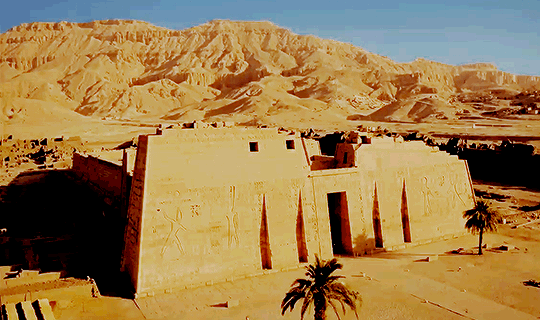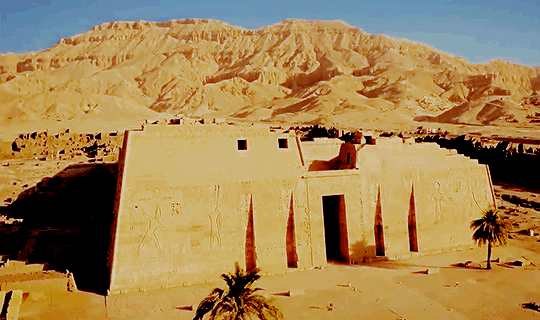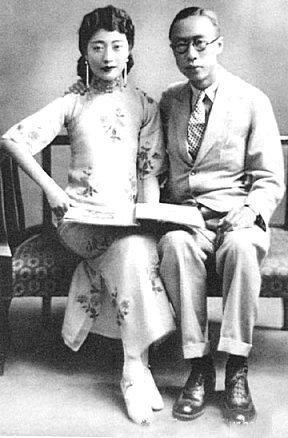#20th Dynasty
Explore tagged Tumblr posts
Text

Tomb of Ramesses VI (KV9), Valley of the Kings, West Thebes. Photo: Jakub Kyncl
601 notes
·
View notes
Text





~ Shabti box.
Period: New kingdom; early 20th Dynasty
Date: ca. 1150 BC.
Place of origin: Thebes (West)
Medium: Wood, painted
#ancient#ancient art#history#museum#archeology#ancient egypt#ancient sculpture#ancient history#archaeology#egyptian#egyptology#egypt#shabti box#20th Dynasty#new kingdom#thebes#ca. 1150 b.c.
695 notes
·
View notes
Text

On this ostracon, sketched in black, the gazelle is the goddess Anuket, emerging from the mountains -- you may have seen many images of the Hathor-cow emerging from similarly stylised hills. Her worshipper, on the other side of a huge pile of offerings, is a royal scribe. Man and gazelle, and the hills, are painted pale orange. I took this photo at the Ramses and the Gold of the Pharaohs exhibition at the Australian Museum.
When: New Kingdom, Dynasty 19/20
Where: Egyptian Museum Cairo
30 notes
·
View notes
Photo


“The Arabic name Medinet Habu (“City of Habu”) was thought to reflect the site's more ancient connection with Amenhotep, the son of Hapu, a respected sage of the 14th century BCE, later deified, whose memorial temple was immediately to the north. No trace of this association has come down from ancient times, however, as the site's formal name in Egyptian was either Djeme, “Males and Mothers”— originally with reference to the eight primeval deities, or Ogdoad, whom the ancients believed to be buried there — although the name continued to be used by the site's later Christian inhabitants.
Medinet Habu's most conspicuous standing monument is the great memorial temple of Ramesses III (reign 1198��1166 BCE). On the grounds of this complex, however, are numerous other structures, most notably the so-called small temple (built in stages, from the mid 18th Dynasty until the second century CE) and the memorial chapels of the divine votaresses of Amun (25th Dynasty and 26th).
Among other ancient buildings at the site, but less well preserved, is the memorial temple of King Horemheb (reign 1343–1315 BCE), usurped from his predecessor Ay (reign 1346–1343 BCE), which abuts Ramesses III's enclosure on its northern side. To its east are a number of tomb chapels made for high officials of the later New Kingdom.
Most abundantly on the enclosure wall of Ramesses III's temple are the remnants of later mud-brick houses — from the town that engulfed the site beginning in the 11th century BCE until the site was abandoned in the 9th century CE. Reuse of Ramesses III's temple was made especially apparent by the decorated doorways that were cut into its northern outer wall during early Christian times, when the Holy Church of Djeme occupied the building's second court.
The great temple of Ramesses III was called the Mansion of Millions of Years of King Usermare-Maiamun; ‘United with Eternity in the Estate of Amun on the West of Thebes.’ The precinct, 210m × 315m, was entered by two stone gates in the mud-brick enclosure wall, on the eastern and the western sides. The western gate — presumably the normal entrance for employees who lived outside the precinct — was destroyed when the temple was besieged in a civil war, during the reign of Ramesses XI (c. 1096 BCE). The eastern entrance, approached by a canal, terminated in a harbour, from which important visitors and statues could enter the temple.”
SOURCE: William J. Murnane, The Oxford Encyclopedia of Ancient Egypt (2001)
#egypt#ancient egypt#egyptology#archaeology#historyedit#mine#my edit#medinet habu#20th dynasty#new kingdom#thebes#waset#luxor#ramesses iii
177 notes
·
View notes
Text

Anthropoid coffin (wood, paint, and stucco) of Prince Amenemhat. Artist unknown; ca. 1186-945 BCE (20th or 21st Dynasty, late New Kingdom/Third Intermediate Period). From Amenemhat's tomb in the Meketre Valley near Thebes; now in the Metropolitan Museum of Art.
#art#art history#ancient art#Egypt#Ancient Egypt#Egyptian art#Ancient Egyptian art#Egyptian religion#Ancient Egyptian religion#kemetic#coffin#woodwork#hieroglyphics#20th Dynasty#21st Dynasty#New Kingdom#Third Intermediate Period#Egyptian Thebes#Metropolitan Museum of Art
115 notes
·
View notes
Text

The #NewKingdom, also referred to as the Egyptian Empire, was the ancient Egyptian state between the 16th century BC and the 11th century BC. This period of ancient Egyptian history covers the Eighteenth, Nineteenth, and Twentieth Dynasties. Through radiocarbon dating, the
2 notes
·
View notes
Text
That's KV 9, built (or at least started) for Ramesses V but eventually used by Ramesses VI!
684 notes
·
View notes
Photo



Puyi, last emperor of China, with his consort Wan Rong, early 20th century
#mdpchina#costume#20th c. china#chinese dress#chinese costume#qing dynasty#early 20th century#china#20th Century#vintage#vintage style#photography
110 notes
·
View notes
Text
Closely connected to the act of name signing was the act of writing poems on walls. As scholars have already pointed out, with beginnings traceable to the Six Dynasties, wall poems (tibishi) were already very widespread during the Tang. By Christopher Nugent's count, well over one thousand entries in the Complete Tang Poems had titles indicating that they began as inscriptions on some surface other than paper or scrolls. These surfaces included walls at places of gathering and transit, such as post stations, scenic sites, inns, and increasingly in the latter part of the Tang, Buddhist temples, which also served public roles for lay gatherings and performances. (100)
In one anecdote, a latecomer casts aspersions on a first writer's literary skills, comparing him to the general Xiang Yu (232-202 BCE), who was infamous for having learned just enough writing to manage his name: "Li Tang signed his name on a pavilion in Zhaoying County. When Wei Zhan [jinshi degree 865] saw it, he took a brush and dashed off a taunt: 'The rivers of Wei and Qin brighten the eyes, / but why is Xiren short on poetic spirit? / Perhaps he mastered only what Beauty Yu's husband could / learning to write just enough to put down his name.' " ... It would not be a stretch to imagine the sniggering of those who read this inscription in a frequented pavilion. (102)
For a degree seeker in Chang'an, these circuits of information and judgment received more discussion than the actual examination itself. Tang literati wrote copiously about activities such as name signing, public exposure, and triumph. It would not be an exaggeration to say that in ninth-century temples and popular recreation areas, the vertical spaces were teeming with verses that clamored for attention. (104)
selections on poetic graffiti from linda rui feng's city of marvel and transformation: chang'an and narratives of experience in tang dynasty china (university of hawaii press, 2015)
#china#tang dynasty#tagamemnon#<- couldn't stop thinking about graffiti from pompeii while reading this chapter so i suspect it may be of interest to rome-heads in genera#this was very promising book that felt like it failed to fully deliver - can't tell if the author was trying not to get into aspects which-#-have a paucity of surviving sources or if perhaps she was trying to avoid stepping on the toes of existing scholarship#e.g. nugent's mentioned book on poetry production/circulation or juduth zeitlin's article on wall poems and anxieties of loss#but even though i felt like it needed another 50-100 pages of fleshing out there are some generally remarkable moments in here#bits that can be put in remarkable parallel with imperial rome certainly; more fascinatingly with 19th- and early 20th-century fiction-#-that deals closely with 'new' modern urban life. where the forms & patterns of the city itself collude with residents against the newcomer#some interesting notes on bai juyi in here too. though i don't know if they're news to any real bai juyi stans out there
39 notes
·
View notes
Text

Dowager Empress Cixi of the Qing Dynasty sitting on an armchair (1906) by Hubert Vos. Palace Museum, Beijing.
#hubert vos#palace museum#beijing#forbidden city#china#imperial china#qing dynasty#20th century art#qing#chinese art#dutch art#dutch painter#1900s art#1906#1900s#edwardian#20th century#early 20th century#netherlands#empress#europe#european art#female portrayal#female portrait#art history#history of art#nobility#chinese empire#historical fashion#fashion history
23 notes
·
View notes
Text

Detail of Ramesses girdle which is woven from linen and decorated with rows of ankh signs, a hieroglyph used to write the word for ‘life’.
New Kingdom, 20th Dynasty, ca. 1186-1155 BC. Now in the World Museum, Liverpool. M11156
Read more
416 notes
·
View notes
Text

~ Seated Baboon.
Date: ca. 1539–1075 B.C. or 664–332 B.C.
Period: New Kingdom or Late Period; 18th-20th Dynasty or 26th-31st dynasty
Medium: Wood
#ancient#ancient art#history#museum#archeology#ancient egypt#ancient sculpture#ancient history#archaeology#egyptian#egyptology#egypt#seated baboon#baboon#wood#new kingdom#late period#18th dynasty#20th dynasty#26th Dynasty#31st Dynasty#ca. 1539 b.c.#ca. 1075 b.c.#664 b.c.#332 b.c.
521 notes
·
View notes
Text

Forms of the great god on the papyrus of Nes-Amun-neset-taui. I'm not sure if the black snake between the two forms at right is coming out of the mouth of the left one with the gazelle head, or is part of the remarkable figure with a djed and an atef crown for a head (but no actual head!).
When: New Kingdom, 20th Dynasty
Where: Neues Museum, Berlin
12 notes
·
View notes
Text

Imperial court gown worn by Grand Duchess Xenia Alexandrovna (1875-1960), sister of Tsar Nicholas II of Russia (1868- 1918).
1890′s-1900′s
📍: The Hermitage, St. Petersburg
#Tsar Nicholas II of Russia#Grand Duchess Xenia Alexandrovna#House of Romanov#Romanov dynasty#imperial court gown#1800s#1900s#19th century#20th century#fashion#court gown
18 notes
·
View notes
Text

A Riverside Village before Rain, Wu Shixian, 1912
#art#art history#Asian art#China#Chinese art#East Asia#East Asian art#Imperial China#Wu Shixian#landscape#Qing Dynasty#20th century art#hand scroll#ink on paper#Yale University Art Gallery
460 notes
·
View notes
Text

Heather Locklear and Matt Clark on the set of Dynasty - 1981
#heather locklear#matt clark#dynasty#1981#20th century#hollywood#classic hollywood#classic television#80s#80s tv#80s tv shows#on the set
8 notes
·
View notes